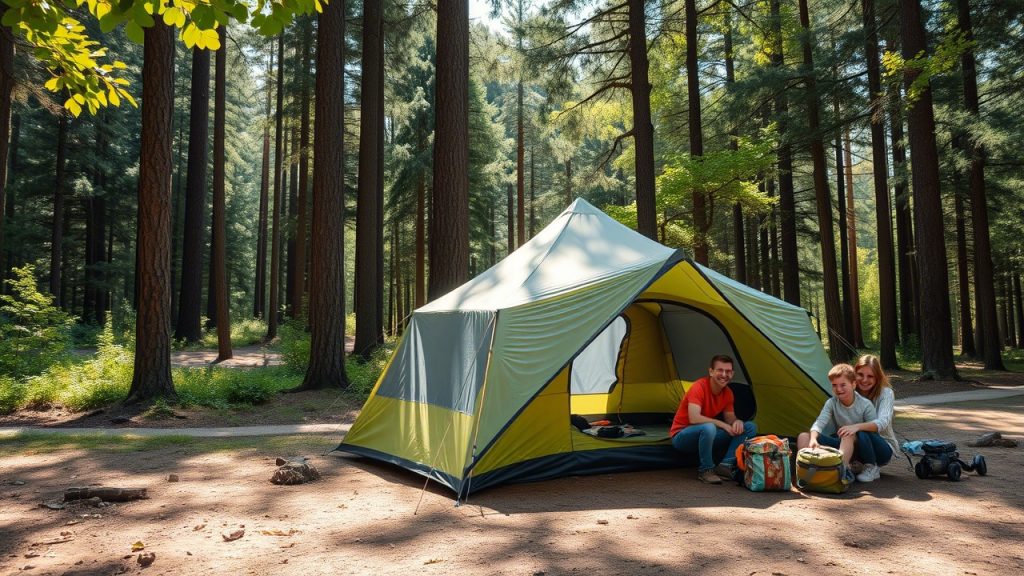Camping in May 2025 offers a chance to recharge under starry skies, but a restless night can turn your adventure into a slog. The right tent transforms your sleep, providing a cozy, weatherproof haven that feels like home. In this guide, we’ve curated the 11 best tent picks to improve overnight comfort, focusing on spacious interiors, ventilation, weather resistance, and ease of setup for car campers, families, and crossover backpackers.
Drawing from expert reviews by Wirecutter, Outdoor Gear Lab, REI, and CleverHiker, plus user feedback and testing in diverse conditions like Joshua Tree’s deserts and Maine’s rainy forests, these tents prioritize livability for restful nights. We’ve included a buying guide, practical tips, 12 frequently asked questions, and a conclusion to help you choose the perfect tent for blissful outdoor sleep.
Why Overnight Comfort Matters in a Tent
A tent isn’t just shelter—it’s your bedroom in the wild. Comfortable sleep boosts energy for hiking, fishing, or simply soaking in nature. Key factors for overnight comfort include:
- Spacious Interiors: Ample floor space (30–80+ sq. ft.) and peak heights (48–78 inches) let you stretch out or stand, as seen in the REI Wonderland 6.
- Ventilation: Mesh panels (50%+ of walls) and vents (e.g., Nemo Aurora Highrise) reduce condensation and keep air fresh.
- Weather Protection: Full-coverage rainflies (1500mm+) and sturdy poles (e.g., The North Face Wawona) shield against rain and wind.
- Ease of Setup: Intuitive designs (e.g., Kelty Wireless 6) save energy for relaxing, not wrestling poles.
- Durability: Robust fabrics (40D–100D or canvas) like the Springbar Traveler ensure long-term reliability.
- Extras: Pockets, dividers, and vestibules (e.g., MSR Habitude) organize gear and enhance livability.
Our picks prioritize 3-season tents with features like dual doors, roomy vestibules, and high peak heights, tested in conditions from Kansas showers to Colorado winds. Whether you’re a solo camper or a family of six, these tents make overnight comfort a reality.
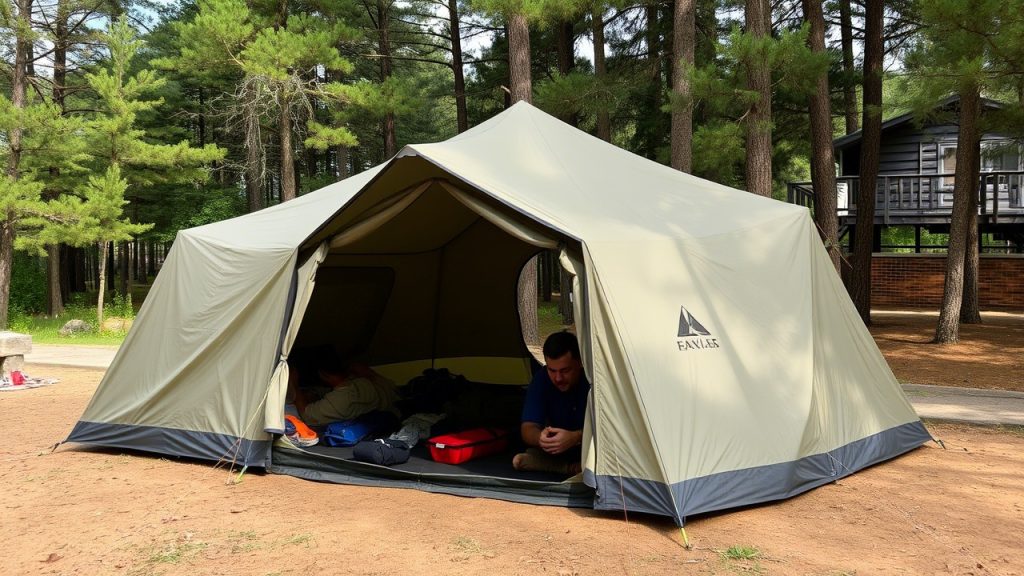
How to Choose a Tent for Overnight Comfort
Before exploring our top picks, consider these factors to select a tent that maximizes sleep quality:
- Group Size: Solo campers need 20–30 sq. ft. (e.g., Sea to Summit Alto TR1); couples require 30–40 sq. ft. (e.g., Big Agnes Copper Spur UL2); families need 80+ sq. ft. (e.g., Marmot Limestone 6P).
- Peak Height: 48+ inches for sitting (backpacking) or 72+ inches for standing (car camping), like the REI Base Camp 6’s 74 inches.
- Ventilation: 50%+ mesh and adjustable vents (e.g., Mountain Hardwear Mineral King) prevent stuffiness in warm or humid conditions.
- Weather Resistance: 1500mm+ rainflies and DAC or aluminum poles (e.g., MSR Habitude) handle spring storms.
- Weight: Ultralight (2–5 lbs., e.g., Nemo Hornet Osmo) for backpacking; heavier (10–20 lbs., e.g., Coleman Skydome XL) for car camping.
- Setup: Freestanding tents (e.g., REI Half Dome SL 2+) pitch easily on varied terrain; color-coded poles speed up assembly.
- Storage: Vestibules (5–44 sq. ft.) and pockets keep gear organized, enhancing interior space.
Test your tent at home to ensure it meets your comfort needs, especially for ventilation and space.
Top 11 Tent Picks to Improve Overnight Comfort
1. The North Face Wawona 6
- Best for: Family comfort
- Capacity: 6-person
- Key Features: 17 lb 3 oz, 86.9 sq. ft. floor, 1500mm rainfly, 76-inch peak height, 10-minute setup, 44.7 sq. ft. vestibule
- Why We Love It: The Wawona 6 is a spacious haven with 86.9 sq. ft. and a 76-inch peak height, tested in Utah’s windy campgrounds. Its 1500mm rainfly and DAC poles ensure dry sleep, while 70% mesh walls and vents keep air fresh. The 44.7 sq. ft. vestibule stores gear, and a room divider adds privacy. Users praise its “front porch” vibe for week-long trips, though the rainfly needs drying to prevent mildew.
2. REI Co-op Wonderland 6
- Best for: Luxurious family camping
- Capacity: 6-person
- Key Features: 22 lb 15 oz, 83.3 sq. ft. floor, 1500mm rainfly, 78-inch peak height, 12-minute setup, 29 sq. ft. vestibules
- Why We Love It: The Wonderland 6 feels like a “royal palace” with 83.3 sq. ft., a 78-inch peak height, and vertical walls, tested in New Mexico’s deserts. Its 1500mm rainfly and four vents ensure weatherproofing and airflow. Two vestibules (29 sq. ft. total) and a room divider enhance livability. Users love its comfort for family naps, but its weight suits car camping.
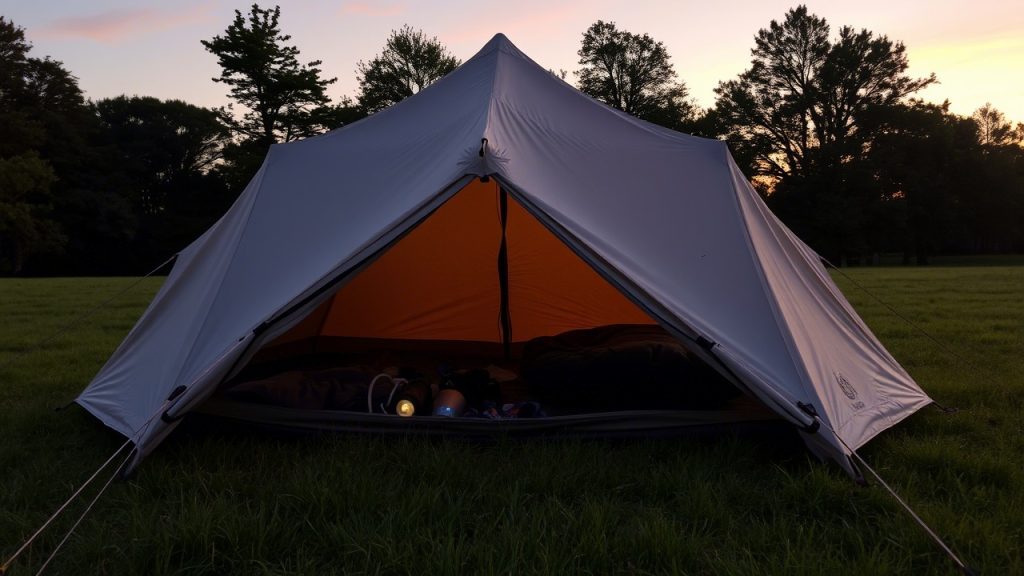
3. Marmot Limestone 6P
- Best for: Weatherproof family sleep
- Capacity: 6-person
- Key Features: 17 lb, 82.9 sq. ft. floor, 1500mm rainfly, 76-inch peak height, 8-minute setup, 14 sq. ft. vestibule
- Why We Love It: The Limestone 6P offers 82.9 sq. ft. and a 76-inch peak height, standing firm in Rocky Mountain storms with a 1500mm rainfly and pre-bent DAC poles. Its 60% mesh canopy balances ventilation and privacy. Setup takes 8 minutes with color-coded poles. Users praise its durability for comfortable group sleep, though the single vestibule limits storage.
4. MSR Habitude 6
- Best for: Premium family durability
- Capacity: 6-person
- Key Features: 14 lb, 83 sq. ft. floor, 1500mm rainfly, 72-inch peak height, 10-minute setup, 27 sq. ft. vestibule
- Why We Love It: The Habitude 6 blends toughness and comfort with 83 sq. ft. and a 72-inch peak height, tested in Colorado’s spring winds. Its 1500mm rainfly, robust poles, and 27 sq. ft. vestibule ensure dry, organized sleep. Setup takes 10 minutes. Users love its longevity for family camping, though it’s pricier.
5. Kelty Wireless 6
- Best for: Budget-friendly comfort
- Capacity: 6-person
- Key Features: 17 lb 3 oz, 86.9 sq. ft. floor, 1200mm rainfly, 76-inch peak height, 10-minute setup, 29 sq. ft. vestibules
- Why We Love It: The Wireless 6 delivers 86.9 sq. ft. and a 76-inch peak height at a budget price, tested in summer storms. Its 1200mm rainfly and deep pole pockets provide stability, while 50% mesh aids airflow. Setup takes 10 minutes. Users love its value for cozy family sleep, but stakes may bend in hard ground.
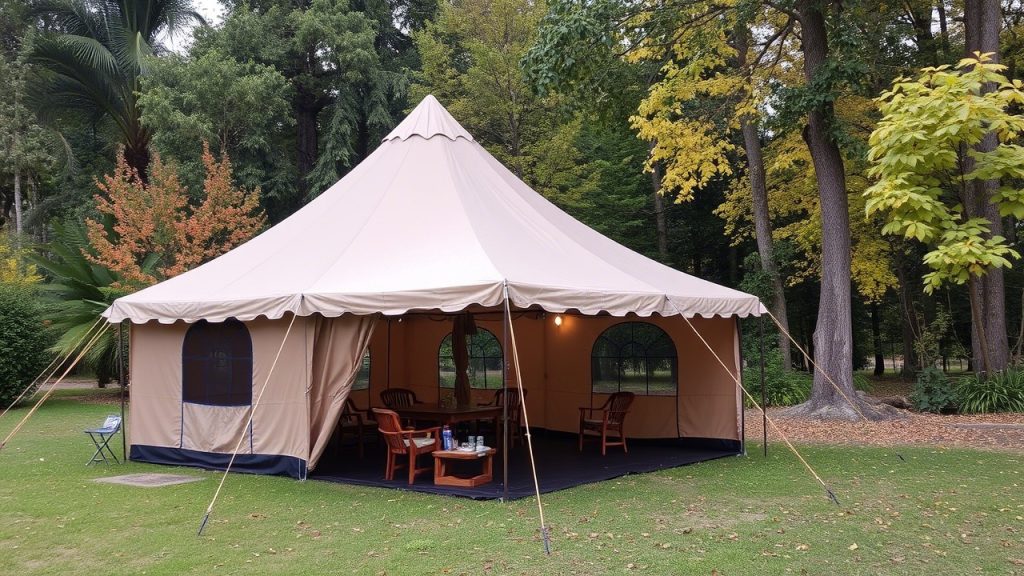
6. Nemo Aurora Highrise 4P
- Best for: Small group ventilation
- Capacity: 4-person
- Key Features: 14 lb, 83 sq. ft. floor, 1200mm rainfly, 76-inch peak height, 8-minute setup, 19.6 sq. ft. vestibules
- Why We Love It: The Aurora Highrise 4P offers 83 sq. ft. and a 76-inch peak height, tested in Lake Tahoe’s humid summers. Its 65% mesh canopy and vents prevent stuffiness, and the 1200mm rainfly ensures dry sleep. Two 9.8 sq. ft. vestibules store gear. Users praise its airy comfort, though it’s less wind-resistant.
7. REI Co-op Base Camp 6
- Best for: Weather-resistant group comfort
- Capacity: 6-person
- Key Features: 20 lb 11.5 oz, 84 sq. ft. floor, 1500mm rainfly, 74-inch peak height, 10-minute setup, 44 sq. ft. vestibules
- Why We Love It: The Base Camp 6 is a fortress with 84 sq. ft. and a 74-inch peak height, tested in Kansas showers. Its geodesic design, 1500mm rainfly, and 44 sq. ft. of vestibule space ensure dry, spacious sleep. Setup takes 10 minutes. Users love its stability for group comfort, though zippers need care.
8. Big Agnes Copper Spur HV UL2
- Best for: Lightweight couple comfort
- Capacity: 2-person
- Key Features: 3 lb 2 oz, 29 sq. ft. floor, 1200mm rainfly, 40-inch peak height, 5-minute setup, 18 sq. ft. vestibules
- Why We Love It: The Copper Spur HV UL2 is ultralight at 3 lb 2 oz, with 29 sq. ft. and a 40-inch peak height, tested on Colorado trails. Its 80% mesh body and 1200mm rainfly balance airflow and weatherproofing. Two 9 sq. ft. vestibules store gear. Users love its cozy comfort for couples, but the 15D floor needs a footprint.
9. REI Co-op Half Dome SL 2+
- Best for: Budget crossover comfort
- Capacity: 2-person
- Key Features: 4 lb 13 oz, 33.8 sq. ft. floor, 1500mm rainfly, 44-inch peak height, 5-minute setup, 22.5 sq. ft. vestibules
- Why We Love It: The Half Dome SL 2+ offers 33.8 sq. ft. and a 44-inch peak height, tested in Oregon’s forests. Its 1500mm rainfly and 70% mesh ensure dry, airy sleep. Two 11.25 sq. ft. vestibules organize gear. Users praise its value for cozy backpacking, though it’s heavier than ultralight options.

10. Mountain Hardwear Mineral King 3
- Best for: Versatile couple comfort
- Capacity: 3-person
- Key Features: 7 lb 13 oz, 42.5 sq. ft. floor, 1500mm rainfly, 48-inch peak height, 7-minute setup, 20 sq. ft. vestibules
- Why We Love It: The Mineral King 3 provides 42.5 sq. ft. and a 48-inch peak height, tested in Joshua Tree. Its 1500mm rainfly, 68D floor, and 70% mesh ensure durability and ventilation. Two 10 sq. ft. vestibules store gear. Users love its stargazing mesh for car camping, though it’s heavy for backpacking.
11. Springbar Traveler 6
- Best for: Long-term canvas comfort
- Capacity: 6-person
- Key Features: 24 lb, 100 sq. ft. floor, Sunforger canvas, 78-inch peak height, 15-minute setup, 3 mesh windows
- Why We Love It: The Springbar Traveler 6 offers 100 sq. ft. and a 78-inch peak height with breathable Sunforger canvas, tested in Utah’s deserts. Its three mesh windows and tight-when-wet fabric ensure airy, weatherproof sleep. Setup takes 15 minutes. Users love its luxurious comfort, but it’s heavy and requires staking.
Key Features for Overnight Comfort
To sleep soundly, prioritize these tent features:
- Spaciousness: 30–80+ sq. ft. and 48–78-inch peak heights (e.g., Wawona’s 86.9 sq. ft.) for stretching or standing.
- Ventilation: 50%+ mesh and vents (e.g., Aurora’s 65%) for fresh air and condensation control.
- Weatherproofing: 1500mm+ rainflies and sturdy poles (e.g., Base Camp’s geodesic design) for dry sleep.
- Storage: Vestibules (5–44 sq. ft., e.g., Habitude’s 27 sq. ft.) and pockets keep interiors clutter-free.
- Ease of Setup: Freestanding designs and color-coded poles (e.g., Limestone’s 8-minute pitch) reduce stress.
- Durability: 40D+ fabrics or canvas (e.g., Springbar’s Sunforger) for long-term reliability.
- Extras: Dividers (e.g., Wonderland) and gear lofts enhance privacy and organization.
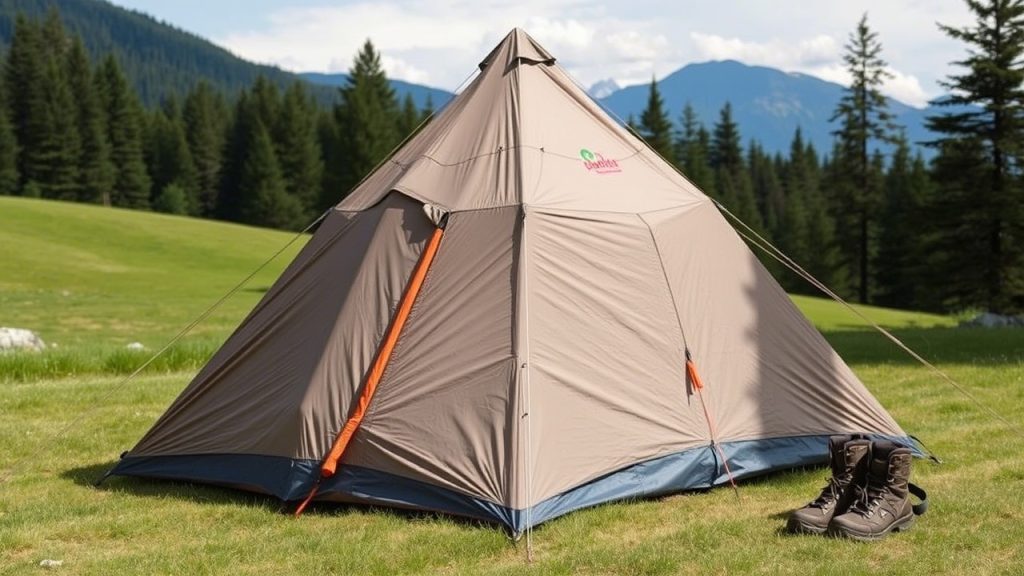
Tips for Comfortable Tent Sleeping
- Choose a Level Site: Pick flat, rock-free ground to avoid sliding, as tested with the REI Base Camp.
- Use a Quality Sleeping Pad: A thick air pad (e.g., Therm-a-Rest LuxuryMap) insulates and cushions.
- Select the Right Sleeping Bag: Choose a 20°F-rated bag for spring camping, like the REI Siesta Hooded 20.
- Ventilate Proactively: Open mesh panels and vents to reduce condensation, especially in humid areas.
- Organize Gear: Store items in vestibules or dry bags to keep interiors spacious, as with the Wawona’s 44.7 sq. ft. vestibule.
- Bring a Pillow: Use an inflatable camp pillow or roll up a jacket for neck support.
- Wear Dry Sleepwear: Change into clean long underwear and socks to stay warm and comfortable.
- Secure Food: Store food in a bear canister or car to avoid wildlife, per park rules.
- Use Earplugs and Eye Mask: Block noise and light for deeper sleep, especially in busy campgrounds.
- Test Setup: Practice pitching at home, particularly for complex tents like the Springbar Traveler.
- Bring a Repair Kit: Pack Gear Aid Tenacious Tape for quick fixes in the field.
- Wind Down: Read or relax before bed to ease into sleep, as recommended by experts.
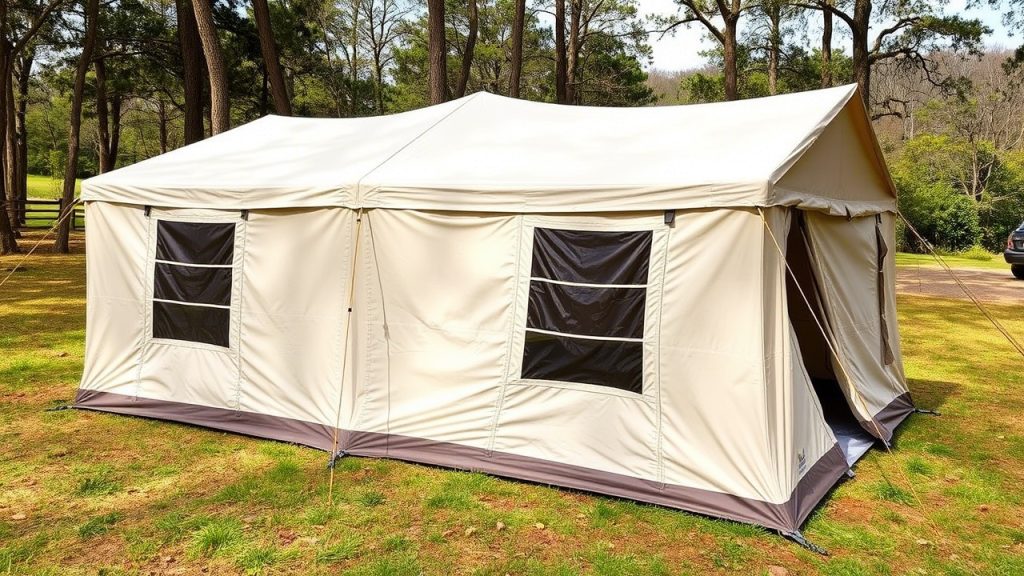
Caring for Your Tent
To maintain comfort and longevity:
- Dry Thoroughly: Air out after trips to prevent mold, especially canvas tents like the Springbar.
- Clean Gently: Use Nikwax Tech Wash and a sponge; avoid machine washing.
- Store Loosely: Keep in a breathable bag in a cool, dry place.
- Repair Promptly: Patch tears and replace zippers or poles as needed.
- Reproof Waterproofing: Apply Nikwax Tent & Gear SolarProof every 1–2 years.
12 Frequently Asked Questions About Tents for Overnight Comfort
1. What makes a tent comfortable for overnight camping?
Comfortable tents offer 30–80+ sq. ft. of floor space, 48–78-inch peak heights (e.g., REI Wonderland’s 78 inches), 50%+ mesh for ventilation, and 1500mm+ rainflies for weatherproofing. Vestibules, pockets, and easy setup (e.g., Kelty Wireless) enhance livability.
2. Are 3-season tents sufficient for comfortable sleep?
3-season tents (e.g., Marmot Limestone) with 1500mm+ rainflies and robust poles handle spring-to-fall conditions, ensuring dry, airy sleep. For colder nights, pair with a 20°F sleeping bag and thick pad.
3. How important is tent ventilation for comfort?
Ventilation is critical to prevent stuffiness and condensation. Tents with 50%+ mesh and vents (e.g., Nemo Aurora’s 65%) keep air fresh, especially in humid or warm climates like Lake Tahoe.
4. What’s the ideal tent size for comfortable sleep?
Solo campers need 20–30 sq. ft. (e.g., Big Agnes Copper Spur’s 29 sq. ft.); couples require 30–40 sq. ft. (e.g., REI Half Dome’s 33.8 sq. ft.); families need 80+ sq. ft. (e.g., Wawona’s 86.9 sq. ft.). Upsize for gear or extra comfort.
5. How do vestibules improve overnight comfort?
Vestibules (5–44 sq. ft., e.g., REI Base Camp’s 44 sq. ft.) store gear outside the sleeping area, keeping interiors spacious and dry. They’re essential for organized, clutter-free sleep.
6. Can lightweight tents be comfortable for overnight use?
Lightweight tents (2–5 lbs., e.g., Big Agnes Copper Spur) offer comfort with 30–40 sq. ft., 70%+ mesh, and 1200mm+ rainflies. They’re ideal for backpacking but may need footprints for thin floors.
7. Are freestanding tents better for comfortable camping?
Freestanding tents (e.g., MSR Habitude) pitch easily on rocky or uneven ground, reducing setup stress and ensuring a stable, comfortable sleep. They’re ideal for car camping or varied terrain.
8. How does peak height affect tent comfort?
Higher peak heights (48–78 inches) allow sitting or standing, improving livability. For example, the Springbar Traveler’s 78 inches lets families move freely, enhancing comfort.
9. Are canvas tents more comfortable than nylon ones?
Canvas tents like the Springbar Traveler are breathable, durable, and spacious (100 sq. ft.), ideal for long-term comfort. They’re heavier (24 lb) but excel for static car camping.
10. How long should a comfortable tent last?
With care, quality tents last 5–15 years or 50–200 trips. Durable models like the MSR Habitude (68D fabric) or Springbar Traveler (canvas) endure frequent use with proper maintenance.
11. How do I manage condensation for better sleep?
Double-wall tents with mesh (e.g., Mountain Hardwear Mineral King’s 70%) reduce condensation. Open vents in dry conditions, store wet gear in vestibules, and wipe walls with a microfiber towel.
12. What accessories enhance tent comfort?
A thick sleeping pad, 20°F sleeping bag, inflatable pillow, earplugs, eye mask, and gear loft (e.g., REI’s Half Dome accessories) improve warmth, support, and organization for restful sleep.
Conclusion
A comfortable night’s sleep in May 2025 can elevate your camping adventure, leaving you refreshed for nature’s wonders. From the luxurious REI Wonderland 6 for families to the ultralight Big Agnes Copper Spur HV UL2 for couples, our 11 tent picks prioritize space, ventilation, and weatherproofing to ensure cozy, restful nights.
Choose a tent with ample floor area, high peak height, and robust features, and follow our tips to optimize your setup. With the right tent as your outdoor bedroom, you’ll wake up ready to explore, connect, and make unforgettable memories under the stars.

